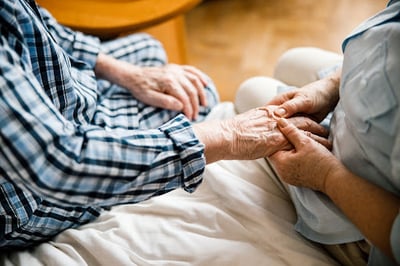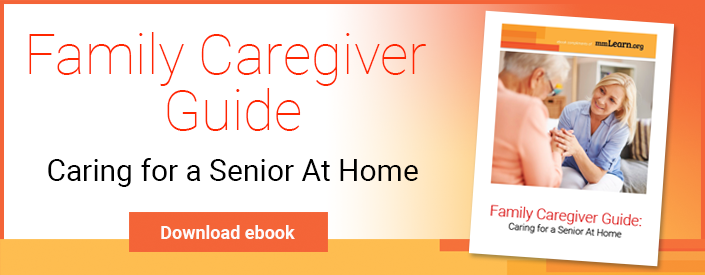 When our hearts are doing their jobs well, they are pumping blood throughout our bodies, getting oxygen to all our limbs. As we get older, it can become harder for the heart to push the blood back uphill to the heart.
When our hearts are doing their jobs well, they are pumping blood throughout our bodies, getting oxygen to all our limbs. As we get older, it can become harder for the heart to push the blood back uphill to the heart.
As a result, poor circulation, especially in legs, is a problem that causes discomfort and pain for many seniors.
Sometimes poor circulation indicates underlying health problems, so it’s important for older folks and caregivers to recognize the warning signs of serious conditions that include poor circulation.
Signs of Poor Circulation
If you’re a caregiver for an older loved one, you might recognize the signs of poor circulation.
The following are some signs to look for:
-
Varicose veins. When the valves of our veins aren’t working as well as they could, they start bulging and leave purple or bluish lines on the skin, especially the legs. Varicose veins are not a serious problem, but they can be painful or feel dry, itchy, or tight. And sometimes they lead to muscle cramps. Compression stockings can help with varicose veins, and there are other treatment options available.
-
Muscle cramps. If your loved one feels cramps in their calf, buttocks, or thighs, it could be related to a narrowing of the arteries called “claudication.” This is something that requires medical attention.
-
Swelling. Blood clots cause swelling when blood builds up and blocks a vessel. They cause swelling and sometimes pain. When a clot occurs in the lower leg, it may be a sign of deep vein thrombosis (DVT).
-
Sores or ulcers. When we don’t have enough blood supply, sores or ulcers can form and take a long time to heal.
-
Edema. This is a buildup of fluid in the arm or leg. It will feel swollen and tight. Usually people take medications called diuretics or water pills to reduce this kind of swelling.
-
Numbness or tingling in limbs.
-
Cold hands and feet.
-
Discoloration in hands and feet. A condition called Reynaud’s phenomenon changes the color of the skin.
-
Erectile dysfunction. A decreased blood flow might be caused by clogged arteries.
Conditions that Lead to Poor Circulation
There are a number of conditions that can cause poor circulation, depriving your limbs of the oxygen they need to work.
-
Deep vein thrombosis (DVT) is a problem that occurs when a blood clot forms in a deep vein. The Centers for Disease Control (CDC) says these clots are most common in the lower leg, thigh, or pelvis. DVT is preventable and treatable. But if clots are not treated, a serious complication can occur where the clot breaks off and works its way up to the lungs, resulting in a pulmonary embolism (PE). Approximately one-third to one-half of people who have DVT develop a complication called post-thrombotic syndrome (PTS).
-
Peripheral artery disease (PAD) is a common circulatory problem where narrowed arteries cause reduced blood flow to the limbs. Seniors and their caregivers need to take it seriously and get medical attention. If untreated, PAD can lead to critical limb ischemia, infarction, and tissue death. It is a cause of amputation, and also increases the risk of stroke or heart attack.
-
Weight gain. We need some fat to fuel our bodies. But too much weight can cause buildups in the arteries. Maintaining a moderate weight helps improve circulation.
-
Diabetes. This condition causes high blood glucose levels, which can damage the lining of blood vessels or cause them to narrow.
If your loved one has been experiencing any of the signs of poor circulation or diagnosed with these conditions, they should be consulting with medical professionals. There are also a number of preventative measures that can help to improve circulation quality of life for seniors.
Improving Circulation
The good news is that many of the things that we can do to improve circulation will also improve mental and physical health in other ways. Here is what experts are saying will help improve circulation.
-
Get moving. Getting up and about is one of the simplest ways to get the blood pumping. Walking, swimming, and even heel-toe exercises while watching television are great ways to give the circulatory system a boost. Just remember to start slow and work your way up when encouraging seniors to adopt new fitness routines. Encourage them to try cardiovascular exercise or yoga.
-
Eat a healthy, varied diet. Fruits, vegetables, oily fish, black and green tea, and whole grains have been linked with promoting circulation. It’s also important to stay well hydrated.
-
Quit smoking. Smoking vastly increases the risk of poor circulation by narrowing the arteries and restricting blood flow, so if your aging loved one smokes, encourage them to quit.
-
Elevate those feet. Warm water soaks and elevation help alleviate pain and swelling while delivering short-term circulatory benefits.
If you are helping your loved one to make these lifestyle changes and their circulation isn’t getting any better, their doctor might recommend medication or surgery. You can also encourage them to talk to a podiatrist to help find the right shoes to protect feet and prevent pain.
Caregivers Matter
Caregivers play an important role in helping loved ones aging at home to identify potential issues and encourage healthy lifestyle changes. Even though poor circulation is common among older people, your loved one doesn’t need to suffer.
By working together, we can look for signs of poor circulation and take steps to manage and treat the symptoms.

